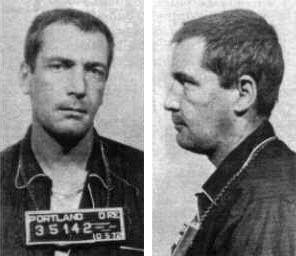Gary Gilmore facts for kids
Quick facts for kids
Gary Gilmore
|
|
|---|---|

Portland Police Bureau mugshots
|
|
| Born |
Faye Robert Coffman
December 4, 1940 McCamey, Texas, U.S.
|
| Died | January 17, 1977 (aged 36) Utah State Prison, Draper, Utah, U.S.
|
| Cause of death | Execution by firing squad |
| Criminal status | Executed |
| Parent(s) | Frank Gilmore Sr. (father) Bessie Gilmore (mother) |
| Relatives | Mikal Gilmore (brother) |
| Conviction(s) | First degree murder Armed robbery (3 counts) Assault (2 counts) |
| Criminal penalty | Death |
| Details | |
| Victims | Max Jensen Bennie Bushnell |
| Date | July 19 & 20, 1976 |
| State(s) | Utah |
| Location(s) | Orem Provo |
|
Date apprehended
|
July 21, 1976 |
Gary Mark Gilmore (born Faye Robert Coffman; December 4, 1940 – January 17, 1977) was an American man who became widely known for his legal case in the 1970s. He was found guilty of serious crimes in Utah. After a major decision by the U.S. Supreme Court in 1976, Gary Gilmore became the first person in nearly ten years to be executed in the United States. This happened under new laws about the death penalty. His life and execution were later featured in a famous book called The Executioner's Song by Norman Mailer. This book was also made into a TV movie.
Contents
Who Was Gary Gilmore?
Gary Mark Gilmore was born in McCamey, Texas, on December 4, 1940. He was the second of four sons born to Frank and Bessie Gilmore. His brothers were Frank Jr., Gaylen, and Mikal Gilmore, who later became a writer.
His Early Life
Gary's father, Frank Gilmore, often moved the family around the Western United States. He earned money by selling fake magazine subscriptions. Gary had a difficult relationship with his father. His youngest brother, Mikal, described their father as a "cruel and unreasonable man."
A Difficult Childhood
In 1952, the Gilmore family settled in Portland, Oregon. As a teenager, Gary started getting into minor trouble. Even though he was very smart and had artistic talent, he left high school in the ninth grade. He once ran away from home to Texas with a friend. After a few months, he returned to Portland.
The Trial and Legal Process
Gary Gilmore was found guilty of serious crimes in Utah. His trial began in Provo, Utah, on October 5, 1976. It lasted for two days. A witness testified that they saw Gilmore at a motel office.
The Court Case
Gilmore's lawyers did not call many witnesses to defend him. Gilmore himself wanted to speak in court. He thought he could explain his actions. However, doctors had said he knew what he was doing. They also said he knew it was wrong at the time. Gilmore then decided not to speak. On October 7, the jury decided he was guilty of a serious crime. They also recommended a death sentence.
Legal Appeals and Decisions
Gary Gilmore chose not to fight his sentence in federal court. However, his mother, Bessie, tried to stop the execution. The US Supreme Court decided not to hear her case. They said Gilmore had given up his right to appeal. His execution was then scheduled for November 15.
Despite his wishes, Gilmore received several delays. These delays were due to efforts by groups like the American Civil Liberties Union (ACLU). The last delay happened just hours before his scheduled execution on January 17. But this delay was soon overturned. Gilmore had said he wanted these groups to "butt out." He stated, "This is my life and this is my death."
His Execution
Gary Gilmore was executed on January 17, 1977. He was executed by a firing squad at Utah State Prison in Draper, Utah. This event was very significant. He was the first person executed in the United States since the death penalty was brought back in 1976.
Gary Gilmore in Pop Culture
Because Gary Gilmore was the first person executed after the death penalty was reinstated, his story became very famous. It had a big impact on culture at the time.
Books and Movies
Norman Mailer wrote a book about Gilmore's life called The Executioner's Song. This book won a major award, the Pulitzer Prize. It explored the debate about the death penalty. In 1982, the book was made into a TV movie. Tommy Lee Jones played Gary Gilmore in the film. He won an Emmy Award for his acting.
Gary's youngest brother, Mikal Gilmore, also wrote a book. His memoir, Shot in the Heart (1994), talked about his relationship with Gary. It also explored their family's history. This book received many good reviews and won awards. In 2001, Shot in the Heart became an HBO film.
Music and Art
The advertising agency Wieden+Kennedy created the famous "Just Do It" slogan for Nike. Its founder, Dan Wieden, said Gilmore's last words inspired this slogan.
The band the Adverts released a punk rock song in 1977 called "Gary Gilmore's Eyes." Another band, ArmsBendBack, also released a song with the same title in 2003. Artist Matthew Barney featured Gilmore as a character in his 1999 film Cremaster 2.
Welsh playwright Dic Edwards wrote a play about Gilmore's life in 1995. It was called Utah Blue.
See also
- Capital punishment in the United States
- Capital punishment in Utah
- The Executioner's Song
- John Albert Taylor
- List of people executed in Utah


